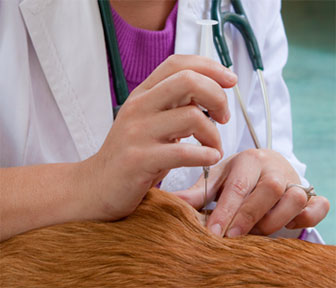FDA is Vigilant About Keeping Your Pets Safe
On this page:
You may know that the Food and Drug Administration (FDA) works to keep foods and drugs safe for you and your family, but you may not realize the agency does much of the same for your pets.
FDA engages in pharmacovigilance; that is, it monitors reports of adverse drug events (unexpected and sometimes serious side effects) from manufacturers, veterinarians and animal owners. Monitoring this information can result in changes in product labeling to better communicate drug safety information. In addition, the agency maintains a website through which consumers can report safety problems related to pet foods.
“People value their pets and may not realize that FDA is constantly on the lookout for signs that there is a medication or food on the market that could result in adverse health events,” says John Baker, a veterinarian and director of the Division of Veterinary Product Safety (DVPS) within the agency’s Center for Veterinary Medicine (CVM).
Drug Safety
In Fiscal Year 2013, FDA received 86,444 reports of adverse drug events from manufacturers, veterinarians, and consumers. Baker explains that while manufacturers are required by law to report adverse drug events, veterinarians and consumers are encouraged to report on a voluntary basis. Instructions for pet owners on reporting can be found at fda.gov.
CVM’s pharmacovigilance efforts can lead to
- revisions in product labels,
- “Dear Doctor” letters to veterinarians warning of potential safety issues,
- client information sheets informing pet owners of important drug information, and
- articles in veterinary journals.
In addition, to get the word out about its pharmacovigilance efforts, FDA reaches out to veterinarians at professional meetings, continuing education courses and conferences. More recently, FDA has begun reaching out to technicians in veterinary practices, too, to encourage them to report issues of concern with veterinary drugs. “We’re suggesting that more vet techs assume the responsibility for adverse event reporting for vets who may be too tied up to do so in the course of a busy day,” Baker says.
Monitoring Errors, Pet Medications
Even if the medication itself is safe for your pet when given correctly, there are a number of ways medication errors can occur when the prescription is filled or when you dispense it to your pet. In 2008, CVM also began monitoring reports of medication errors and focusing on ways to increase the safe use of those medications by pet owners.
According to Linda Kim-Jung, a pharmacist and safety reviewer in DVPS, some causes of medication errors include:
- drug names that look alike or sound alike;
- drug labels that look alike;
- drug dosage devices (such as oral syringes) that are difficult to use because of poor design or unclear directions for use;
- use of error-prone abbreviations or symbols on written prescriptions;
- illegible handwriting on prescriptions; and
- miscommunication when verbally prescribing orders.
To help prevent such errors, CVM evaluates drug names, labeling, packaging and product design before a drug is approved, Kim-Jung says.
“After a drug goes on the market, we also review adverse drug reports, which sometimes describe medication errors,” Kim-Jung adds. FDA also educates veterinary professionals and the public about veterinary medication errors and ways to minimize and prevent medication errors. For more information, please see the FDA/CVM Veterinary Medication Errors web page.
Monitoring Problems with Pet Foods
Pet foods also come under FDA’s purview.
Lee Anne Palmer, VMD, a veterinarian and safety reviewer at CVM says that consumers may recall that in 2007, FDA confirmed that many dogs and cats in the U.S. were developing kidney failure after eating pet foods contaminated with the chemical compound melamine. Pet food manufacturers voluntarily recalled more than 100 brands of dog and cat food across the nation as a result of an intensive investigation by the FDA.
More recently, FDA has asked veterinarians and pet owners to report dog illnesses related to eating chicken, duck, or sweet potato jerky treats, nearly all of which are imported from China. As a result, FDA has received many well-documented case reports that will greatly assist its continuing investigation into pet illnesses and deaths associated with these products.
“Although the pet food supply in the U.S. is very safe, we want to be as aware as possible of any problems connected with animals eating pet foods,” Palmer says. “To that end, we encourage consumers to report adverse events they think may be related to pet foods and to provide as much information as possible.” In calendar year 2013, CVM received over 3,000 pet food adverse event and product problem reports.
FDA scientists analyze trends over time and may identify clusters of illness tied to a particular product, looking for consistencies in such things as lot numbers or brand names. This kind of information helps FDA target problems and decide whether to collect product samples for laboratory analysis. “Many product recalls have been a direct result of adverse event reporting by animal owners, veterinarians and manufacturers,” Palmer says.
Pet owners, veterinarians, and concerned citizens can report complaints about pet food products electronically through the agency’s Safety Reporting Portal. The online questionnaire asks for information about brand name, product type, package size, lot number and use-by dates. Petowners and veterinarians can also report by calling the FDA District Offices.
Palmer says that lot numbers and use-by dates are particularly important in helping FDA track down potential problem sources. Consumers can also find the answers to frequently asked questions about pet food safety reporting at fda.gov.
May 21, 2014
Return to FDA Consumer Articles

